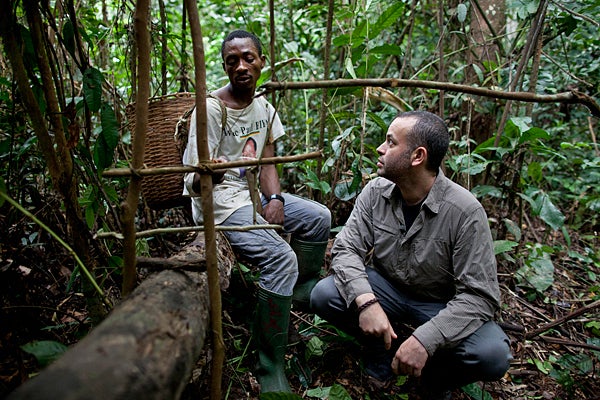|
October 25, 2011
New book by Stanford biologist looks toward future of pandemic prediction
Prevention rather than just treatment should define future interactions between humans and deadly viruses, argues Stanford visiting human biology Professor Nathan Wolfe in his new book, The Viral Storm. By Sarah Jane Keller

Human biology Professor Nathan Wolfe watches a Cameroonian hunter set a trap. Wolfe has found that close contact between bushmeat hunters and wild animals puts hunters at the front lines for infection with new pathogens, and for collecting samples that help detect novel animal viruses. (Photo: Jonathan Torgovnik) In the blockbuster movie Contagion, jet-setting lifestyles help a deadly virus travel the world, unraveling society and sending researchers scrambling to develop a vaccine.
During the script's development, Nathan Wolfe, a visiting Stanford human biology professor, invited the Contagion screenwriter to a seminar where undergraduates learn to view the world from a microbe's perspective.
"Some of the students did an extra credit project to come up with fictional-but-plausible deadly viruses that we shared with him," Wolfe said. "It was definitely great fun for everybody."
While the class enjoyed contributing to the scientific credibility of the movie, Wolfe and his independent nonprofit research group, the Global Viral Forecasting Initiative, are working to make sure the drama of Contagion stays on the movie screen.
The Viral Storm
In his new book, The Viral Storm: The Dawn of a New Pandemic Age, Wolfe chronicles the changes in human behavior that have shaped our experience with pandemics and he ultimately provides a vision for predicting and preventing future outbreaks.
Wolfe's firsthand knowledge from over a decade of virus hunting is woven throughout the book. His early work in Cameroon, in west-central Africa, sent him to villages where the inhabitants relied on wild game, or bushmeat, for protein. When hunters contact animal fluids during butchering, it makes them especially vulnerable to hosting novel bugs. Many viruses, like HIV and influenza, jumped to humans from other animals.
Hunters are important allies for studying emerging disease. By enlisting them to collect thousands of blood samples, Wolfe and his colleagues found unique forms of viruses, including retroviruses like HIV. Since then, Wolfe and his team have established the Cameroon monitoring system in countries throughout the world, including China, Southeast Asia and other parts of central Africa.
While viruses may emerge from far-flung places, Wolfe emphasizes that modern transportation networks help microbes spread faster than ever. For that reason, Wolfe says The Viral Storm is written "for anyone who rides the subway, or takes an airplane, or kisses their children goodbye on their way off to school."
Plague Prediction
The global connectivity that helps viruses spread also makes them easier to track. San Francisco-based Global Viral Forecasting Initiative works in 20 countries, trying to find potential pandemics. A digital surveillance team monitors chatter on hundreds of websites, looking for the signal of a threatening outbreak in online noise. By combining technology with boots-on-the-ground natural science, GVFI aims to catch viruses before they become world travelers.
"In the last chapter of the book I portray a fictional scenario for the future of how I hope that we'll address some of these pandemics," Wolfe said. "I think the exciting thing about GVFI is that we're really working on a daily basis to move that towards a reality."
To predict and prevent the next pandemic, GVFI will rely equally on hunters in Africa and analysts crunching data in California. "Whether it's epidemiology or virology or computer science, we bring all of those to bear to find the best solutions to addressing these problems," Wolfe said.
Wolfe wants to confine images of plague-racing vaccine developers to movies like Contagion. "Historically, the way we've focused on disease control when it comes to pandemics is very much a reactive, responsive approach," he said. "I think now we've crossed the threshold into having a lot of organizations and governments that now recognize that prediction is important."
According to Wolfe, stopping deadly bugs before they spread also depends on how individuals think about pandemics. In The Viral Storm, he talks about "risk literacy," referring to the ability to compare and interpret relative risks.
"I think there is a real importance for people to understand the nature of these risks," Wolfe said. "And while we may not perceive them in the way that we perceive more visually traumatic risks like hurricanes and earthquakes, they represent, in many ways, more profound threats."
Nathan Wolfe is the Lorry I. Lokey Visiting Professor in Human Biology at Stanford University and founder and CEO of Global Viral Forecasting Initiative.
Sarah Jane Keller is a science-writing intern at the Stanford News Service.
-30-
|